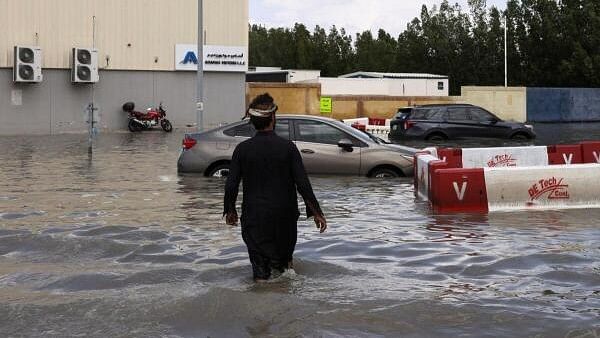
A person walks towards cars stranded in flood water caused by heavy rains, in Dubai, United Arab Emirates, April 17, 2024.
Credit: Reuters Photo
By Lara Williams
The sights coming out of the United Arab Emirates this week range from surreal to apocalyptic: Rolls Royces and Aston Martins floating in flood water, a plane taxiing across a runway-cum-lake, furniture flying off the balcony of a high-rise apartment. But blaming weather modification for Tuesday’s downpours, which caused flash flooding and killed at least 18 people in neighboring Oman, is almost certainly wrong.
Reports suggest that almost six inches (15.2cm) of rain fell on Dubai in 24 hours, about a year and a half’s worth of average annual precipitation. A 1-in-100-year rainfall event for the region— meaning weather with a 1 per cent chance of happening every year, would produce about 2.4 inches in a day. So what happened this week was more than double that intensity.
The flooding is fairly easy to explain: Vulnerabilities are typically established in communities before the weather turns nasty. As a mostly dry region with intermittent rain showers in the winter months, the Middle East hasn’t designed its cities for high rainfall. When I was in Dubai for COP28, it felt like a concrete jungle, with huge asphalt highways, sprawling glass buildings and paved squares. Given the abundance of impermeable surfaces and insufficient drainage, all that rain had nowhere to go.
But what produced the downpour? Bloomberg News suggests a link between the precipitation and the UAE’s cloud-seeding efforts, which began in 2002 as an attempt to address water security issues. To increase rainfall, salt is released into existing clouds in warm weather, with the intention that larger droplets will form and eventually lead to rain.
Ahmed Habib, a meteorologist, said that seeding planes were dispatched on Monday and Tuesday to take advantage of promising cloud formations. The National Center for Meteorology (NCM) later denied that it had carried out weather-modification techniques before the storms hit.
Weather-modifying technology has an air of mysticism about it. When China, which has invested billions in advanced weather control methods, said it cleared the skies for the 2008 Beijing Olympics by forcing rain to come early, few questioned it. But despite the investment of huge amounts of money into the technique, the jury is still out on how effective it can be.
Researchers at the University of Colorado and the National Center for Atmospheric Research were able to demonstrate in a study called SNOWIE that cold-weather cloud seeding using silver iodide can create additional snow. But the mechanics, seeding agent and clouds are completely different when trying to produce rain in warm weather.
Cloud seeding can only enhance whatever moisture is already in the sky. It can’t create rain from nothing. UAE officials say that the technique can increase rainfall rates by about 10 per cent to 30 per cent a year, meaning that even if it did happen earlier this week, a huge amount of rain was due to fall anyway.
Instead, as Friederike Otto, a climatologist and senior lecturer at Imperial College London’s Grantham Institute for Climate Change and the Environment, said in an emailed statement to me: “When we talk about heavy rainfall, we need to talk about climate change.”
A warmer atmosphere can hold more water, meaning that rainfall around the world is becoming much heavier. The Middle East is no exception. A 2022 study published in the Review of Geophysics found that greenhouse gas emissions aren’t just leading to more severe heat waves and droughts in the region, but stronger torrential rain, with semi-arid and arid regions projected to see a 5 per cent to 10 per cent increase in the intensity of 1-in-30-year rainfall events by the end of the 21st century if emissions continue to be high.
A study from scientists at the NCM published this year said that annual precipitation in the UAE will increase by as much as 30 per cent across the country, with extreme precipitation becoming more frequent. So it’s likely that this week’s destruction isn’t the result of us trying to play God with the weather, but comes instead from a different human-made creation: Climate change.